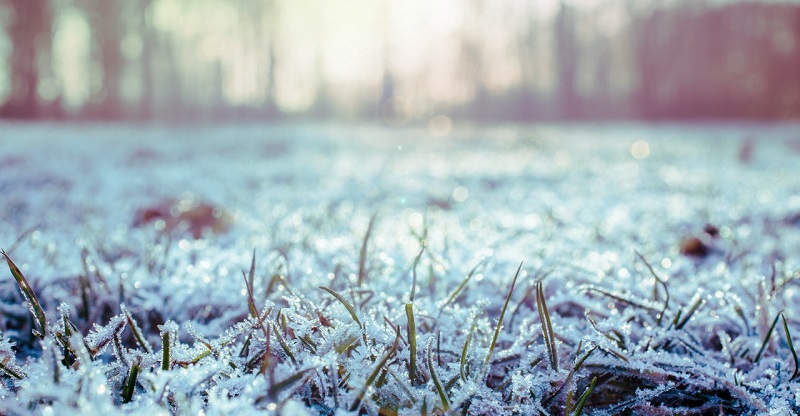Temperatures that plunge below 0 degrees, snow and frost are all inevitable winter realities for millions of homeowners across the country. There’s no escaping these harsh conditions, not for you and not for your lawn. But are these super cold conditions bad for your grass and will frost damage fresh cut grass? That’s the question that we’re going to be answering in this post.

The Short Answer…Yes!
To understand why, it’s important to be aware of what actually happens when you cut your grass. So when you pass your mower over it you are slicing the individual grass blades to make them shorter. Tell me something I didn’t already know? Well when you do this, you’re essentially creating an open wound on every single blade of grass (many people don’t think of their lawn as a living organism). And this wound needs time to heal, just like a cut on your finger would.
Now during the summer months, the warmer temperatures, the abundance of sunlight and numerous other factors mean that grass grows extremely rapidly, and is able to recover from these “wounds” much more quickly. But during the winter, when the temperatures drop, this rate of growth slows right down and it takes much longer for your grass to recover after a cut.
How Will Frost Damage Fresh Cut Grass?
Let’s go back to the analogy of the cut on your finger for a second. When you have a cut like that, if you don’t keep it clean, protect it from extreme conditions and give it the time it needs to heal, there is a chance that it could get infected, which is obviously not good for your health.
When freshly cut grass, or should I say freshly wounded grass, is exposed to sub-zero temperatures and a sharp frost before it’s been able to heal, there is a much higher risk of frost damage and infection. It’s quite likely that you may see the following symptoms:
- Yellow or brown discoloring in spots around your lawn
- Dead patches of grass
There’s a good chance that your lawn may suffer from grass rot if there’s a frost shortly after you mow, and fungal lawn diseases such as Snow Mold (also called Fusarium Patch) are also quite common in this situation too. None of this is very good news for your lawn, and the chances of you having a lush green surface to look out onto in the spring are unlikely.
Prevention is Better than the Cure: Protecting Your Lawn from Frost
Have you ever heard the old expression that “an ounce of prevention is worth a pound of cure”? Well, that definitely rings true here. You’re better off knowing what not to do when you have incoming frost, rather than trying to figure out how to help your lawn recover from frost damage after the fact. Here are a few tips that should stand you in good stead.
- Learn the “Frost Dates” for Your Region – Historical data relating to the weather for your local area is archived on the internet and is just a quick Google search away. Your best protection against the dangers of frost is to educate yourself on local weather trends. When does the first frost typically hit in the winter? When do you usually see the last frost in the spring?
- Look at the 7 Day Forecast Before You Mow – Just being aware of historical weather trends is not enough though. As cold fronts can suddenly move in and cause freak weather incidents. So it’s always advisable to look at the weather forecast for the next several days or week. If it’s predicted that temperatures will drop anywhere close to freezing, you probably shouldn’t mow. Better to be safe than sorry!
- Stop Mowing Altogether as Those “Frost Dates” Approach – Ideally, you want to give your lawn a buffer period before the first frost of the winter hits. We’d recommend that you give your grass a final cut for the year roughly 2 weeks before the frost historically descends upon your part of the world. And the same goes for the springtime too. Wait two weeks after the predicted last frost of spring before you give your lawn the first cut of the year.
- Temp During the Day is 40 Degrees or Lower? – If the answer to this question is “yes” then I’d be very hesitant to pull the mower out, as if it’s that cold during the day, temperatures will almost certainly fall close to or under freezing during the night. And that means frost.
While it’s tempting to mow and get the lawn looking nice and tidy for the winter, resist the urge and leave your mower right where it is if frost is likely. It’s honestly better to leave your grass a little longer for the winter period, keeping it in great shape health-wise, than to cut it shorter and risk all of the negative implications frost damage can have for your lawn.




Thank you so much. This was very helpful.
Grass is very hardy. A slight frost will not damage it if not cut too short.
Hi David,
I appreciate that most cool-season grasses are very hardy and don’t feel the effect of frost nearly as much as warm-season grasses. However, I’ve seen a few instances where warm-season grasses have been cut when the temperature drops below 0°, and there have been some harmful effects. I’ve even seen warm-season grass with footprints in because the lawns had been walked over when frosted. So, I guess it comes down to how cold it is and what type of lawn it is.
Thanks for the comment.
Tom.